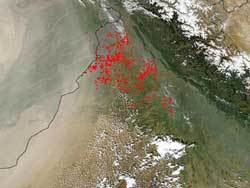
Feature
Asian Summer Monsoon Stirred by Dust in the Wind
09.07.06
 Image right: Dust and smoke from fires (red points) over northwestern India/Pakistan may contribute to a change in rainfall patterns over the region. Click image to enlarge Credit: NASA
Image right: Dust and smoke from fires (red points) over northwestern India/Pakistan may contribute to a change in rainfall patterns over the region. Click image to enlarge Credit: NASAA monsoon is a seasonal shift in wind direction that brings alternate very wet and very dry seasons to India and much of Southeast Asia.
NASA research scientist William Lau of NASA's Goddard Space Flight Center, Greenbelt, Md., and his team studied the aerosols. They recently found that aerosols in the form of airborne dust lofted from the desert surface combined with black carbon from industrial emissions, bio-fuel burning, and forest fires can heat the air by absorbing the sun's radiation, which can alter the Asian monsoon cycle. Rains from this annual weather cycle are a lifeline to over 60 percent of the world's population. Up to now, not much was known about how aerosols interact with the atmosphere to influence monsoons.
Lau's computer simulations found that these heat-absorbing aerosols, when spun together with warm air currents and moisture, cause a heating effect in the air that triggers the rainy period earlier than usual, lengthening the monsoon season in Asia.
 Image left: Space Shuttle view of haze and pollution over Northern India swept in from Tibet. Click image to enlarge Credit: NASA
Image left: Space Shuttle view of haze and pollution over Northern India swept in from Tibet. Click image to enlarge Credit: NASA "Traditionally, aerosols have been seen as only a local environmental problem. Until very recently, aerosols have not been viewed as an intervening presence in the atmosphere that could affect monsoon rains," said Lau. "This study is the first to link dust aerosols to monsoon rainfall changes and to claim a specific physical mechanism in the atmosphere, whereby the tiny dust particles interact with the monsoon heat and moisture."
The mechanism operates like an "elevated heat pump," according to Lau. Increased dust or aerosols blowing in from western China, Afghanistan, Pakistan and the Middle East coupled with black carbon emissions from northern India accumulate before the monsoon in late spring against the northern and southern slopes of the Tibetan Plateau.
When the dust absorbs the sun's radiation, it heats the surface air hovering above the mountainous slopes of the region. The heated air rises, and draws warm, moist air in to northern India from the Indian Ocean, like a "heat pump." The warm moist air helps to create more rainfall. The rising motion or air associated with more rain in turn brings in more warm, moist air. The "heat pump" effect actually brings on the monsoon season prematurely in northern India, leading to a longer rainy season.
 Image/movie right: "What is a monsoon?" -- The monsoon is a seasonal reversal of rain, from southwest in summer, to northeast in winter. The monsoon is particularly pronounced over Asia, often characterized by heavy rains. It provides abundant water resources to Asian countries during the summer Click image to view movie (no audio) Credit: NASA Data Assimilation Office
Image/movie right: "What is a monsoon?" -- The monsoon is a seasonal reversal of rain, from southwest in summer, to northeast in winter. The monsoon is particularly pronounced over Asia, often characterized by heavy rains. It provides abundant water resources to Asian countries during the summer Click image to view movie (no audio) Credit: NASA Data Assimilation OfficeThe rising motion associated with the "elevated heat pump” effect will shift the monsoon's path toward the foothills of the Himalayas, meaning that more rain will fall earlier in the season (in May) in northern India as a result, and less over the Indian Ocean to the south. The intensified heat and rain may cause increased mountain glacier melt, leading to more erosion in Nepal and near the Ganges River.
"An improved understanding of the effects of aerosols on the monsoon seasonal cycle benefits both science and society," said Lau. "Understanding the relationship between aerosols and the cycle of rainfall has a potential impact on water resources all over the globe."
Lau's research team is currently examining the aerosol effect on rainfall over South America and West Africa, where they are also finding that the “elevated heat pump” mechanism seems to be at work.
Related Links:
+ Climate Research at Goddard
+ NASA's Earth Science missions
+ AERONET
Goddard Space Flight Center